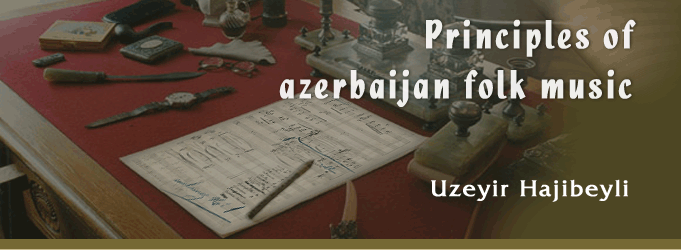

Part two
PRINCIPLES OF COMPOSING MUSIC
IN AZERBAIJANI MODES IN FOLK STYLE
I. STRUCTURE OF PERFECT QUARTES5. Composing music in the mode "Segah"
A. Diapason of the mode scale"Segah"
Three equal tetrachords structured by formula 1/2-1-1 and combined conjointly (chain combination) form the mode scale "Segah". Here the first degree of the medial tetrachord is a tonic of the mode.
With the tonic mi of the first octave the scale of the mode "Segah" can be presented in the following way:
This scale consists of successive number of perfect quartes.
B. Modal functions of the degrees and permissible leaps
In the scale of the mode "Segah":
1-st degree of the scale functions as a subtonic of the main tone. Leaps are not allowed from this degree.
2-nd degree of the scale, the main tone, functions as a lower third of the tone. Leaps from the given degree are allowed to the tonic, to the supertonic of the keynote, to the quinte and to the supertonic of the quinte.
3-rd degree of the scale has not got any function.
4-th degree of the scale functions as a tоniс of the mode. Leaps from this degree are allowed: upwards - to the quinte of the main tone, downwards - to the third (main tone).
5-th degree of the scale functions as a supertonic. From this degree leaps are allowed: upwards - to the supertonic of the quinte of the main tone (with an obligatory conclusion in the quinte), downwards - to the main tone.
6-th degree of the scale functions as a quinte of the main tone. Leaps from this degree are allowed: upwards - to the octave of the main tone, downwards - to the tonic and the main tone.
7-th degree functions as a supertonic of the main tone quinte. Leaps from this degree are allowed: upwards - to the octave of the main tone, downwards - to the supertonic of the keynote.
8-th degree of the scale functions as a mediant in relation to the quinte of the main tone. Third-like leaps are possible from this degree only in sequences.
9-th degree of the scale functions as an octave of the main tone. Leaps from this degree are allowed only downwards: to the quinte of the main tone and to the supertonic of the same quinte.
10-th degree functions as a boundary tone of the mode scale. Leaps from this degree are not allowed.
C. Table of permissible leaps
D. Full and Half Cadences
Full cadence ends with a tonic. The tonic can be approached gradually only from above and directly by leap from the main tone.
Examples of full cadences:
Half cadence can be expressed by stop in the main tone quinte. This above degree can be approached only gradually from above and from below, as well.Examples of half cadences:
[ Segah: pages 1 2 ]



